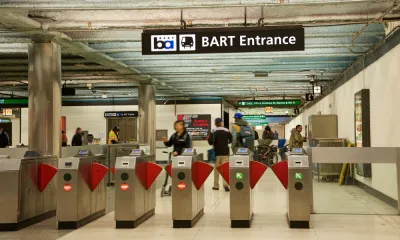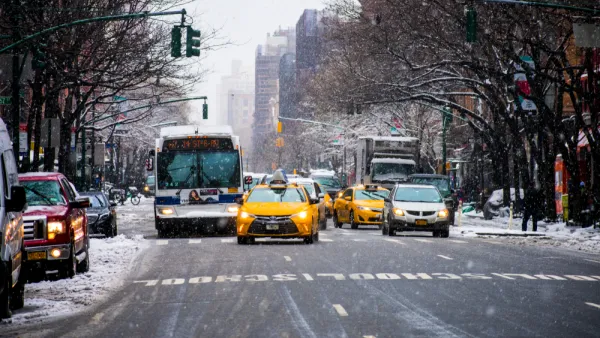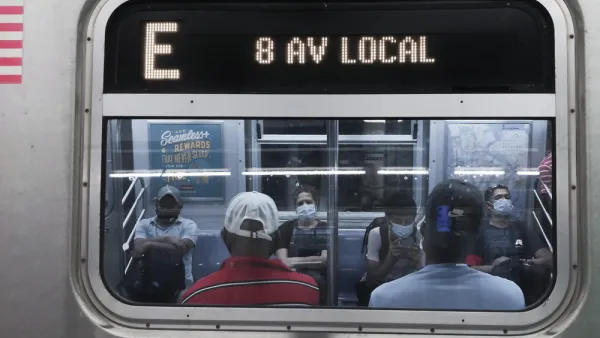San Francisco and New York exemplify the political challenges in finding long-term finding solutions for public transit in the post-pandemic United States.

“Across the country, transit agencies that depend heavily on fare revenues face a “fiscal cliff” in the near future when federal pandemic aid runs out,” according to an article by Daniel C. Vock for Route Fifty. “Ridership on these systems (and, therefore, fare revenues) have not returned to pre-pandemic levels.”
Citing the San Francisco and New York regions as the leading examples of transit systems struggling to make ends meet while facing a “fiscal cliff,” and seeking solutions that would generate more revenue for transit while charging more for the use of cars (a proposed bridge fee recently came up short in the legislature in California, while New York is continuing to face obstacles in implementing congestion pricing through a cordon system in Manhattan).
But both California and New York are trying other solutions to the transit fiscal cliff as well. “Lawmakers [in the state of New York] agreed to dedicate $1.1 billion a year from payroll taxes to help fund the MTA. They also promised a share of the licensing fees from an anticipated casino in the city, and added a one-time payment of $300 million.”
California’s solutions were less comprehensive, according to Vock: “transit advocates had to fight to avoid cuts in state support that [Gov.] Newsom originally proposed. The governor and lawmakers had to make up for a $32 billion anticipated deficit, about a 10th of the size of the state’s annual budget. Ultimately, lawmakers found $5 billion statewide through 2025 to stave off cuts to bus and rail service. But $4 billion of that is capital money that transit agencies can now use for operations.”
As noted by Planetizen coverage in recent years, the fiscal crisis facing public transit was only temporarily relieved by the massive federal stimulus bills approved since 2020, but the underlying issues facing transit persist in 2023. As noted by Vock, San Francisco and New York City are not the only cities facing the fiscal cliff brought about the pandemic.
Across the country, many other transit systems face similar financial predicaments. In the Washington, D.C., area, subway and bus operator WMATA faces an operating deficit of $750 million starting next summer. Transit agencies in the Chicago area warn that they will soon face a $730 million shortfall on their own. New Jersey Transit could see shortfalls of $1 billion.
More details can be found at the source article below, but public transit as we have known in the United States, even with the shortcomings inherent to co-existing in a car-centric planning era, is still at risk several years after Covid-19 arrived in North America.
FULL STORY: Transit agencies scramble to piece together funding as ‘fiscal cliff’ looms

National Parks Layoffs Will Cause Communities to Lose Billions
Thousands of essential park workers were laid off this week, just before the busy spring break season.

Retro-silient?: America’s First “Eco-burb,” The Woodlands Turns 50
A master-planned community north of Houston offers lessons on green infrastructure and resilient design, but falls short of its founder’s lofty affordability and walkability goals.

Delivering for America Plan Will Downgrade Mail Service in at Least 49.5 Percent of Zip Codes
Republican and Democrat lawmakers criticize the plan for its disproportionate negative impact on rural communities.

Test News Post 1
This is a summary

Test News Headline 46
Test for the image on the front page.

Balancing Bombs and Butterflies: How the National Guard Protects a Rare Species
The National Guard at Fort Indiantown Gap uses GIS technology and land management strategies to balance military training with conservation efforts, ensuring the survival of the rare eastern regal fritillary butterfly.
Urban Design for Planners 1: Software Tools
This six-course series explores essential urban design concepts using open source software and equips planners with the tools they need to participate fully in the urban design process.
Planning for Universal Design
Learn the tools for implementing Universal Design in planning regulations.
EMC Planning Group, Inc.
Planetizen
Planetizen
Mpact (formerly Rail~Volution)
Great Falls Development Authority, Inc.
HUDs Office of Policy Development and Research
NYU Wagner Graduate School of Public Service





























